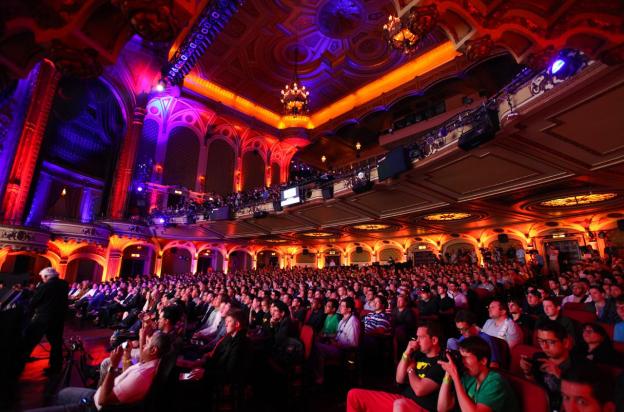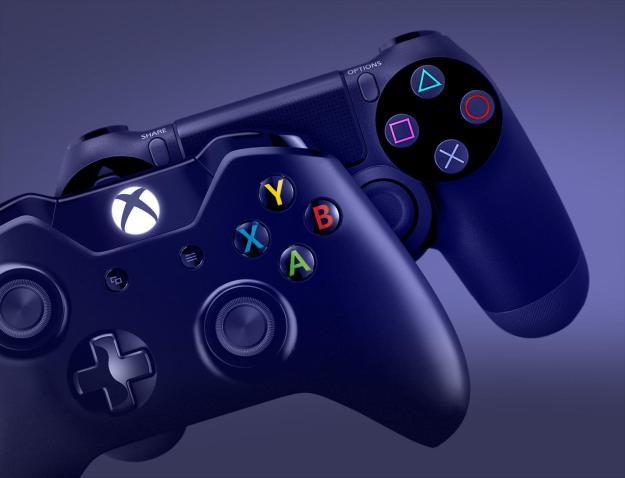
If you have any interest in gaming and you own a TV, computer, phone, ham radio, or have even a single friend with the same interest, then you probably know that last week marked a seminal E3. We’ve got two new gaming consoles on the way that mark more than just a graphical and hardware jump; they also expand gaming in directions we may not have thought possible a few years ago.
Sony and Microsoft’s new bouncing baby systems and their related items were the headliners, but there was plenty more to see. The new consoles begat new software, the new software begat new peripherals, the new peripherals begat some boss new stickers to plaster over them, and then there were all the other companies scrambling for attention. Some of this new tech that may not have an immediate effect on the gaming industry, but give it a year or two. Here are a few of our favorite new technologies from E3 2013 that deserve a closer look.

New consoles: Cloud Processing, SmartGlass integration, and streaming games.
This road has already been well plowed, but you can’t talk new tech from this E3 without at least mentioning some of the new technology that will be integrated in the new consoles from Microsoft and Sony – and not just the obvious stuff like better processors and the like.

Cloud processing is an integral part of the new Xbox One, and it means that Microsoft can crunch some of the numbers required to play a game remotely, rather than inside the console. Potentially, that means Microsoft could upgrade the hardware in some far-flung corner of the US, and gamers everywhere would see better performance without changing a thing themselves or paying a penny more (we sincerely hope). It could be used for everything making games more detailed, to smartening up the AI. You will need a relatively constant Internet connection to make use of it all – feel free to freak out at that – but it is an interesting new approach to console gaming.
SmartGlass. SmartGlass, which folds mobile devices like phones and tablets into the gaming experience, isn’t new. But Microsoft is finding new ways to take advantage of it. Take the game Dead Rising 3. Let’s say you are at home relaxing on the couch, playing the zombie-murder title and cheerfully mutilating thousands of ex-humans, when your phone rings. You pick it up, prepared to make an excuse for not calling someone back, or not going into work last week as you played the game, but instead it’s a character in the game calling you. Not to, you know, ask how your day was or anything though. (If you think gaming characters are talking to you, it might be time to seek professional help.) Instead, the character gives you in-game missions that are available only through the app you install on your smartphone or tablet.

Streaming technology. Upset about the lack of backwards compatibility in the next gen? Sony has you covered thanks to its Gaikai streaming service. Not only can you play current-gen games. In theory, you’ll be able to play every Sony game released. Ever. That makes for thousands of options, and it isn’t limited to the PS4. The Vita can also become a client, meaning you’ll potentially be able to stream high-quality games to your handheld – and other devices may be announced soon (like smartphones). OnLive fans might cry foul at listing this as new tech, but judging by OnLive’s numbers, there aren’t that many of you around.
Oculus Rift
Picture this: You sit down in a comfy chair, throw on sound cancelling headphones, grab a controller, then put on the Oculus Rift VR headset. All you see is the cockpit of a space fighter, your own digital body, and the only sound is your avatar’s breathing. Then the ship fires itself out of a tube into an asteroid field and you begin a full, 360-degree dog fight. You need to look in every direction and watch for enemies while constantly moving. Dodging debris is a good thing, but using it to your advantage is better. You fire a missile and watch it go, craning your neck to see if it finds its target. Then, with a distant explosion, your team wins. This was EVE VR, a demo concocted by the people behind EVE Online. It is mind-blowing, and they did it in seven weeks.
The Oculus Rift tech doesn’t just allow you to look at current games in a new way, it creates new opportunities in gaming. And it is coming soon. The device is still technically just a prototype, but developer can buy a version cobbled together out of components that will be replaced and improved in the eventual commercial release. That full retail version, including better resolution and a more comfortable fit, is still likely a year or more away though, and developers are already excited.

Omni
Virtuix’s Omni is a companion to the Oculus Rift, and it too creates new possibilities in the way we game. It’s a standing platform that you step into while wearing special, frictionless soles on your shoes. Its concave floor allows you to run or walk in place with a natural gait, and that movement is then translated into a game, replacing commands like the “W” key or up on a thumbstick with a step forward. Paired with the Oculus Rift and a light gun, it is very much like stepping into the game. There are still some kinks to work out, like strafing and jumping, but it is immersive.
The Omni is still in in the middle of its Kickstarter campaign, but the device hit its initial goal within a day and is closing in on $1 million with 34 days to go. Physically running in a video game probably won’t be for everyone, especially those with a comfy couch and a dislike of exercise, but it creates so many possibilities that just weren’t achievable before.

Power A’s Moga controllers
The Moga controllers are well-made devices that can connect via Bluetooth to most smartphones and tablets, but they are also one more thing that you need to carry with you. The next generation, however, has a neat new trick.
If you are on the road a lot and you use your smartphone often (judging by the zombie-like faces of hundreds of people you see walking blindly across the street, there are a lot of you) you’ve had problems with your battery. It’s OK, it happens to all of us, and it doesn’t make your device any less of a phone. Battery power packs can help, but they’re generally bulky, heavy, and beyond their sole purpose of charging small devices, they don’t really do much else. When not charging, they just kind of sit there. Taking up space. Kind of like a freeloader that can do one thing well that you wish you didn’t need them to do. The new Moga controller is also a power pack, so now your cumbersome portable charging device actually has a secondary function, and a cool one at that.

ViviTouch
Microsoft has made a big deal about its new controller, including the quad-haptic motors inside. Instead of just feeling the odd rumble, you will now be able to feel location-based feedback that can travel across the controller, not unlike stereo sound, but on a tactile level. While Microsoft is pushing forward with this new haptic expansion only now, ViviTouch is one of its pioneers.
ViviTouch offers haptic technology on a higher level. The company is currently working with the Unity engine to streamline its inclusion, and the results are promising. In one stick you may feel the character’s heartbeat, while another buzzes to let you know an enemy is near. A third and fourth could then vibrate to signify a grenade explosion nearby. This technology is here now, and it gives more options to gamers. The question isn’t if developers, publishers, and manufacturers embrace this technology, but simply when and to what degree.
Editors' Recommendations
- E3 needed to end, but its demise is a net negative for the gaming industry
- The future of E3 is in question again as ESA reportedly seeks a 2025 reinvention
- With E3 2023 gone, other gaming events need to step up
- Ubisoft will not attend E3 2023, but it will still host a summer live stream
- Nintendo confirms that it won’t be part of E3 2023



